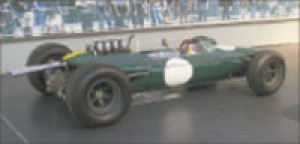This column first appeared in May 2013
While it didn’t seem so at the time, 1963 was the most revolutionary year in the history of American automobile racing. Two cars entered by Team Lotus of Great Britain and powered by engines produced by the Ford Motor Corporation were entered and made such an impression that the traditional front engine machines that were the standard equipment for the time would be totally gone from the Indianapolis Motor Speedway by 1967.
The first rear engine car to appear at the Motor Speedway was in 1961. World Formula 1 driving champion Jack Brabbam of Australia drove his F-1 Cooper Climax to a ninth place finish. The car was seriously under-powered but was able to gain ground in the turns. Dan Gurney, who had already established himself as one of the world’s most competitive race car drivers, had come to Indianapolis as an entrant in the 1962 event. He competed in a rear engine car designed by John Crosthwaite and entered by Mickey Thompson. The car was powered by a stock block Buick V-8 engine. Gurney qualified in 8th position and ran in the top ten until eliminated by an oil leak. Gurney had invited Team Lotus owner and manager Colin Chapman to watch the 1962 race with the idea that Chapman could design and build a Lotus racing car that could truly be competitive in the event. He got Chapman and Ford Motor Company together to create an engine with enough horsepower to keep up with the Meyer-Drake “Offy’s.”
The 1963 Month of May started off with the usual pomp and excitement. Parnelli Jones was driving his “Calhoun,” his Meyer Drake powered Watson Chassis roadster, in which he had in 1962 become the first diver to crack the 150 mph lap barrier. Jim Hurtubise was behind the wheel of a NOVI, as was rookie Bobby Unser. Dan Gurney and Scotsman Jimmy Clark would be driving brand new Lotus 29’s designed exclusively for racing at Indy. Clark’s Lotus was colored British racing green. Green was considered an unlucky color around the Speedway and there was some controversy about it, with some track veterans asking that the car be made to change its color scheme. Formula 1 driving champion Graham Hill was offered a chance to drive a new Chevrolet-powered Crosthwaite-designed rear engine car entered by Mickey Thompson, but declined due to it’s erratic handling. Veteran Dwayne Carter would wind up as the driver.
The Lotus was cigar shaped and low slung with the driver almost lying back in the cockpit as opposed to sitting up straight in the roadsters. This would be a very difficult position for the American-born drivers to adapt to. They had superior handling ability in the turns, and the Ford engine, although technically a stock block, gave the car solid power. The Lotus cars were making everyone in Gasoline Alley very nervous.
As the first day of qualifications approached, Dan Gurney’s Lotus was reaching speeds of around 150 miles per hour and he was establishing himself as a possible challenger for a front row starting position. However, the Friday before the first day of qualifications Gurney’s car hit the wall. Gurney would have to qualify the back-up car. Meanwhile Clark was impressing everyone with his skill and his adapting to the track.
The first qualifying day arrived and in a rain-shortened session, Parnelli Jones grabbed the pole with a new qualifying record of 151.153. He was joined by Jim Hurtubise and Don Branson. Jimmy Clark would qualify for 5th starting position. Dan Gurney would qualify in the second day session and start 12th.
Memorial Day was a warm Thursday as the starting field lined up. Parnelli Jones took command but found himself being closely dogged by the rookie Clark and he had to use all the tricks of his trade to keep Clark at bay. Late in the race Jones developed a serious oil leak and the track was becoming dangerously slick. Chapman went to Chief Steward Harlan Fengler and demanded that the number 98 roadster be black flagged and removed from the race as called for by the rules. Parnelli’s owner J. C. Agajanian claimed that the oil level in the car was lower than the crack in the pan that it had been leaking through and was no longer a factor. He also reminded Fengler that if his car was disqualified, the funny green Lotus Ford would win and that would be a slap in the face of the Indy Car establishment. Fengler did nothing and Jones went on to win the race, albeit with several cars — including Eddie Sachs and Roger McCluskey — spinning in the oil on the last few laps. Clark finished second to Jones, exercising great caution in the closing moments to stay on the track. Dan Gurney finished seventh.
Jones won but the point had been made. The green “funny” rear engine cars were here to stay and were definitely the car of the future and the roadsters were dinosaurs whose time for extinction had come.
Clark would take the Lotus 29 to the Milwaukee track later in the summer and set the track record to win the pole. He would lead all 200 laps, dominating the field to a win. It would be the first time a rear engine car would win an American Champ Car race. In the tragic 1964 500 mile race, Clark would win the pole with a record smashing 158:828 mph run, driving a Lotus 34 with a Ford engine. A. J. Foyt would win the race in a front engine roadster in 1965. It would be Jimmy Clark driving a Ford powered Lotus 38 to Victory Lane at the Brickyard that completed the rear engine revolution.
It is very hard to remember that a half century has gone by since the Lotus arrived at The Indianapolis Motor Speedway. So happy anniversary to all those who helped bring about this revolution.



